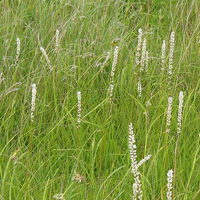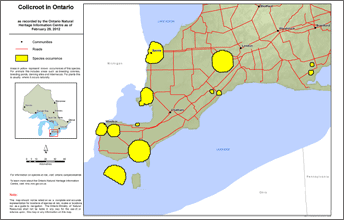Colicroot
Scientific name: Aletris farinosa

Cover photo credit: Linda Tucker
Status
Endangered
"Endangered" means that the species lives in the wild in Ontario but is facing imminent extinction or extirpation.
Date added to Species at Risk in Ontario List
The Colicroot was already assessed as threatened when the Endangered Species Act took effect in 2008. It was reassessed as endangered in June 2016.
Read the assessment report (PDF)
What it looks like
Colicroot is a member of the lily family. It has a tall flowering stalk that reaches 40 to 100 centimetres and holds many white to creamy white, tubular flowers, ending with six spreading lobes, arranged in a long spike.
This plant has thin, pale yellowish-green leaves that reach about eight to 15 centimetres in length. A cluster of leaves surrounds the base of the stem in a star-shape, which inspired the other common name for this species, "Stargrass." Each fruit contains up to 1000 seeds.
Where it lives
In Ontario, Colicroot grows in open, sunny, and moist habitats with sandy or mucky soil, such as prairies and old abandoned fields.
It has also been found along roadsides and forest edges. It does not tolerate shade or competition from other plants and appears to do well in areas that are kept open by fire, drought, grazing and other disturbances.
Where it’s been found in Ontario
In Canada, Colicroot is found only in southwestern Ontario.
View a larger version of this map (PDF)
What threatens it
The main threat to Colicroot is habitat destruction due to residential and road development and natural changes, such as when open fields gradually change into thickets and forests. This process is called "natural succession".
Invasive plants such as Scots pine, which shade out this sun-loving plant, are a problem in some areas, along with recreational activities such as ATV use.
Action we are taking
Endangered Species and their general habitat are automatically protected.
Recovery strategy
A recovery strategy advises the ministry on ways to ensure healthy numbers of the species return to Ontario.
Read the executive summary and full document (June 15, 2017)
Government response statement
A government response statement outlines the actions the government intends to take or support to help recover the species.
Read the government response statement (February 27, 2018)
Review of Progress
A review of progress made toward protecting and recovering a species is required no later than the time specified in the species’ government response statement, or not later than five years after the government response statement is published if no time is specified.
Read the report on progress towards the protection and recovery of 11 species at risk, including Colicroot (2023).
Habitat protection
General Habitat Protection - June 30, 2013
What you can do
Report a sighting
- Report a sighting of an endangered animal or plant to the Natural Heritage Information Centre. Photographs with specific locations or mapping coordinates are always helpful.
Volunteer
- Volunteer with your local nature club or provincial park to participate in surveys or stewardship work focused on species at risk.
Be a good steward
- Private land owners have a very important role to play in species recovery. If you find Colicroot on your land, you may be eligible for stewardship programs that support the protection and recovery of species at risk and their habitats.
- Invasive species seriously threaten many of Ontario’s species at risk. To learn what you can do to help reduce the threat of invasive species, visit:
www.ontario.ca/invasivespecies
www.invadingspecies.com
www.ontarioinvasiveplants.ca - Pollinators, such as bees, are in steep decline across the globe and they play a key role in the survival of many of Ontario’s rare plants. For information on how you can help scientists monitor pollinator populations in Ontario visit:
www.seeds.ca/proj/poll - Colicroot and many other species at risk depend on healthy grassland prairies, a habitat that is very rare in Ontario. Learn more about this habitat, the species that depend on it, and what you can do to help at:
www.tallgrassontario.org.
Report illegal activity
- Report any illegal activity related to plants and wildlife to 1-877-TIPS-MNR (847-7667).
Quick facts
- Aboriginal people used Colicroot to treat colic, digestion problems, coughs, and fevers.
- Colicroot is also known as "Ague root" because it was used to treat some fevers, which were often referred to as "ague" in Middle English.
- Colicroot is pollinated by bumblebees and flies. The plant’s small seeds are scattered by the wind.
